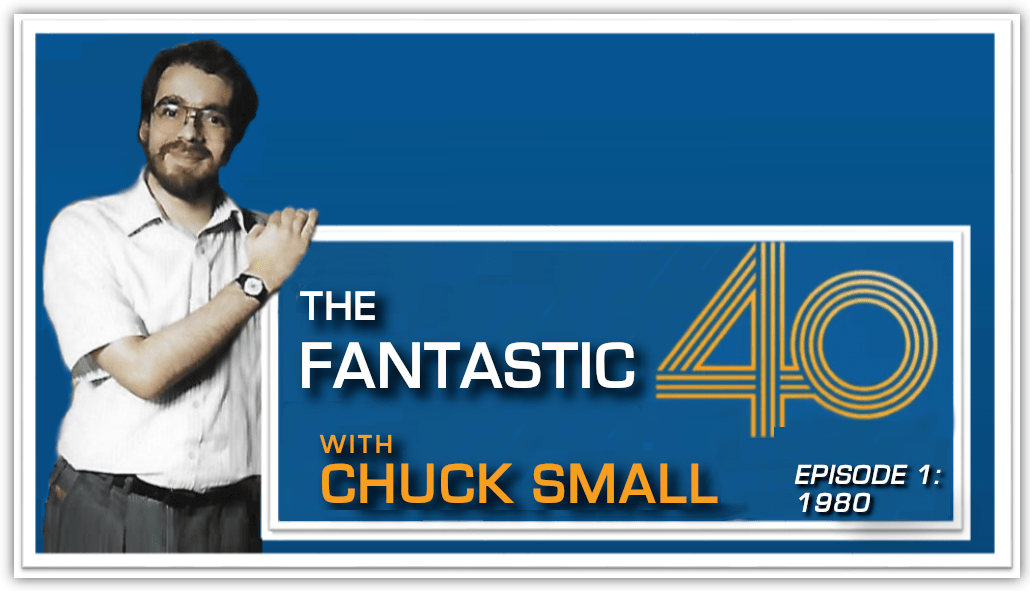Welcome to a look at the Fantastic 40 – the artists whose work dominated Billboard’s Top 40 for each calendar year between 1980 and 1991.

Like many TNOCS folks, I dutifully listened to “American Top 40,” just about every week between late 1974, when I stumbled upon it, and 1991 (a few years after Casey Kasem stepped down from the show he co-created, and went on to his own rival countdown).
I would keep handwritten copies of Billboard’s Top 40 in folders and, at year’s end, develop a list of the top artists.
The method was simple: Count the number of weeks in the Top 40 for each hit by artist, and total them.
Ties were broken by the number of songs charted. An artist who earned 20 weeks with one particularly hot song ranked below an artist whose multiple songs combined for 20 weeks on the chart.
Superstar collaborations were treated as their own act, not split among the collaborators.

So, in 1980, Kim Carnes would have received points for “More Love,” while the points given to “Don’t Fall in Love With a Dreamer” went to Kenny Rogers and Kim Carnes.
As a result, Kim didn’t make the Top 40 of1980 as a solo act. She’ll get her time soon, though.
Recently, I came across my old notebooks.


Now that I owned Joel Whitburn’s decade-long Hot 100 books, I didn’t need to keep them.
And feeling more practical and less sentimental these days about the amount of stuff in the house, I tossed them…
…But not without keeping the Year-End Artists’ lists. They reveal new ways of looking at the artists who dominated a decade. From time to time, we’ll dive into these lists and see what they tell us about the particular year.
What were the stories of 1980’s Fantastic 40?
• The trend: Soft rock.

From Number 40, Barry Manilow…


To Number 1, Billy Joel…

…the mainstays of “Mix” radio stations are well represented.
Cliff Richard (19), Ambrosia (20), Rupert Holmes (21) and the Dirt Band (27) have their best chart year ever.



Some artists buck the trend: Pink Floyd, via the monster “Another Brick in the Wall,” ranks No. 37.


And with three hits led by the year’s No. 1 song, “Call Me,” Blondie comes in at No. 15.

• New names:

Say hello to Tom Petty and the Heartbreakers (29), Irene Cara (23), and Pat Benatar (12). Petty and Benatar break through without much help from AC radio (although today their hits would easily fit in at most stations).


And two acts that will not let up for the first three years of the decade: Air Supply (2) and Christopher Cross (3).

• Final bows:

The Eagles, on the verge of breaking up, place No. 22.

But 1980 also was the last year Jermaine Jackson would place among the 40 hottest artists, though he did have several Top 40 singles through 1986.

The Spinners shine at No. 9 before burning out their chart run.

Other surprises: Electric Light Orchestra (28), Dr. Hook (17)…

And: two of the year’s Top 10 artists – Boz Scaggs (outpacing his “Silk Degrees” run at No. 10)…


and, shockingly: Queen (6).

Yes, if I’d kept track just a few more years, they would have returned via their perennial rhapsody.
• Only in 1980:

Alas, Robbie Dupree (14), we never got to know you better.

• Women on the move:
In addition to Cara and Benatar, Olivia Newton-John, Bette Midler, Barbra Streisand, Linda Ronstadt, Donna Summer and Diana Ross all earn spots among the Top 40 artists. All will return to the Fantastic 40, although in the case of Streisand and Ronstadt, through duets.
• Time and again:
Several artists are just getting going: Eddie Rabbitt (33), Dan Fogelberg (25), Kenny Loggins (18), Kool and the Gang (16), Daryl Hall and John Oates (24).

Though he won’t be the powerhouse he was in the ’70s, Elton John (36) will return.


As will Bob Seger and the Silver Bullet Band (7).

And if anyone thought Michael Jackson was hot at No. 5 for 1980:

… just wait …
Let the author know that you liked their article with a “Green Thumb” Upvote!






Probably not exactly what Chuck was looking to emphasize:
But I have no choice but to say:
“Wow! Would you look at that Penmanship!“
Impressive stuff. If it was my notebook you’d be saying; “Wow! Would you look at that mess!”
If I’d concentrated a little more on accuracy and less on penmanship, I’d have realized that the second Manilow hit should be “I Don’t Want to Walk Without You” … but thanks, just the same, for the compliment! (My penmanship has not held up these days, but I suspect most of us could say that…)
My writing looks like what I’ve seen from serial killers. Lovely cursive (and article!) Chuck.
I’ve said this elsewhere but I’m always surprised at how different each of Blondie’s hits were. “Heart Of Glass” is nothing like “Call Me” which is nothing like “Rapture” which is nothing like “The Tide Is High.” A band after my own genre-jumping heart.
It’s also crazy that they followed debut single “X-Offender” with the gorgeous “In the Flesh.” The latter was one of my key Long Distance Relationship tunes during grad school. An eternal favorite.
https://www.youtube.com/watch?v=fNWopQB8hAw
Another great example!
Love that you kept the notebooks all these years. Totally appreciate the effort that went into recording these stays. I had my own notebooks full of all sorts of stats derived from my British Books of Hit Singles and Albums; average chart position for an act, average weeks in chart per single/album, most weeks per record label and many more. All consigned to the dustbin a few years later.
So many of us did this, keeping track of the records, chart positions, and other such arcana. But really, what was a pre-internet stat fiend to do?
I had the notebooks, too, and remember my schoolmates thinking that I was an oddball for maintaining such data. “Who cares?” was commonly heard – even though when baseball was the topic, every one of them knew the significance of .406, 714, and 2,130, stone cold.
I used to compile football (soccer) stats before i moved onto music. Never mentioned either to anyone, I knew it wouldn’t exactly improve my social standing in school and they were entirely for my own benefit.
.406, 714 and 2,130 – Είναι όλα ελληνικά για μένα
There’s never a sabermetrician around when you need one…
Now you’re just making up words!
I’ve already shared my mixtapes from the 80s which I still have (and no place to play them), but my catalogue of what I owned is from 2007 when I sold my collection.
1980 was really where I began purchasing my own music and tracking the top hits like you did, Chuck. A few thoughts:
‘Boz Scaggs belonged to my father…’ Ugh. Another reminder of the passage of time. Still, I hope you enjoy your trip through Scaggs-land. His three album stretch of Silk Degrees, Down Two, Then Left, and Middle Man is cool pop at its finest, and one of my favorite LP runs.
Great blog, Chuck! Have you perhaps calculated the rankings if you didn’t split points for superstar collaborations? Would that have pushed Kim Carnes into the top 40?
I have not, Ozmoe, but I’m confident Kim would have made it. The real beneficiary would have been Olivia Newton-John. “Magic” wouldn’t have enough chart weeks on its own to push ONJ in 1980’s Fantastic 40, but Xanadu, Suddenly and her duet with Andy Gibb, I Can’t Help It, probably would have pushed her near or into the Top 10.
Oops … that’s what I get for replying without checking: Olivia did make the 40 on her own. I’ll post the full list in the comments in future installments, so as not to bog down the actual post.
1980’s Fantastic 40:
OK, Ozmoe. Including collaborations (marked by *) really would have shaken things up. Our friend thegue would be happy to know that Mr. Manilow would have fallen out of the 40, as would Jermaine Jackson, to make room for the entering Kim Carnes and Andy Gibb (each of whom had one solo hit and one collaboration). Of the acts already in the countdown, the ones most affected would have been Kenny Rogers, vaulting to No. 1, 3 points ahead of Billy Joel if “Don’t Fall in Love With a Dreamer” is included, and Olivia Newton-John, who leaps from 39 to 4, just behind Air Supply, if collaborations “I Can’t Help It,” “Xanadu” and “Suddenly” are added to “Magic.”
I’ve said it before, but 1980 was the year I was absolutely one with the radio. I was 9 turning 10 and I practically loved everything that came out (with a few exceptions). At this point I wasn’t writing the charts down, but I was recording the #1 song on cassette each week. If there was a repeat, I would record Casey introducing it, but wouldn’t record the song again.
I song you mentioned, but I rarely hear about anymore, was Boz Scaggs “Breakdown Dead Ahead”. I LOVED that song, but didn’t get a copy for years.
This is fun stuff!
That same album(Middle Man) also had ‘You Got Some Imagination,’ a great album cut.
I am now going to check that out.
Both “Biggest Part of Me” and “You’re the Only Woman” reminds me of Song Hits magazine. Ambrosia was on the cover. It also reminds me of sugar cane. The store is gone. The sugarcane is gone. It’s a HomeDepot now.
How does a record company come to the conclusion that “One Way or Another” will do well in the US, and “Sunday Girl” in the UK? According to Wikipedia, there was a simultaneous release. I think “Sunday Girl” had a good shot of charting in the US. Parallel Lines sounds like a greatest hits album.
It’s not that I dislike Madonna, but if people started writing disparaging things about Debbie Harry, I’d probably respond. Whenever I hear Prince’s title track for Dirty Mind, I think of “Heart of Glass”, I always wonder if it was an answer song. Heart. Mind. Both songs have that synthesis thing going for it.
Song Hits magazine – that takes me back. Used to be the only way to confirm the correct lyrics to sing along with back in the pre-internet days (and if the artist didn’t bother to include the words on the album jacket).
The last time I picked up a copy was in early 1988, and one of the songs included was – no joke – “Pump Up The Volume”.
I don’t have the time now to review my top artists of 1980 that I used to list on the mothership but in reviewing your list from 1980,I think this was a reaction from the shattering of the Disco stranglehold on the charts of the late ’70″s.
Solo artists were back in vogue.
Just thinking out loud and no research to prove it but I believe the early part
of each decade of rock and roll had this phenomenon (’50’s, ’60’s, ’70’s, ’80’s and ’90’s).